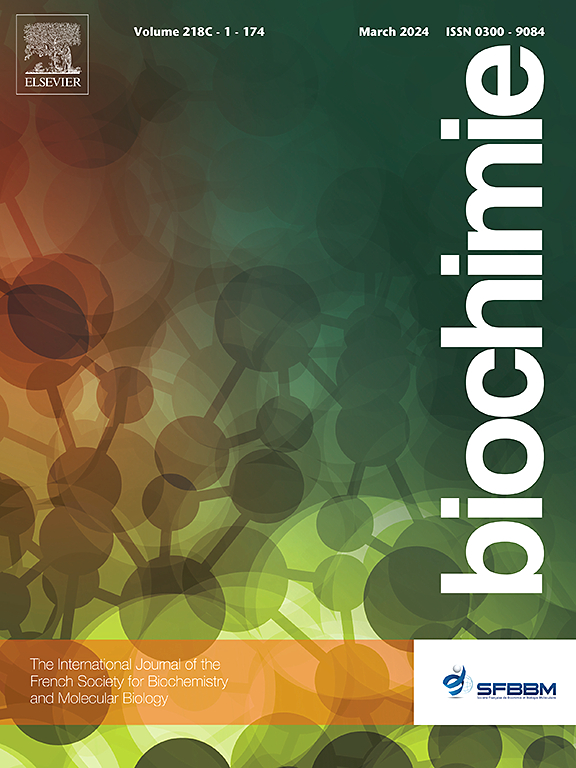Crystal structure of Leishmania orientalis triosephosphate isomerase at 1.88 Å resolution and its specific inhibitors
IF 3.3
3区 生物学
Q2 BIOCHEMISTRY & MOLECULAR BIOLOGY
引用次数: 0
Abstract
Leishmania orientalis, previously called L. siamensis, is a new species characterized as causing cutaneous leishmaniasis in Thailand. This study solves the crystal structure of the L. orientalis triosephosphate isomerase (LoTIM) in apo form at 1.88 Å resolution by using molecular replacement method. Tyrosine118 presents in the LoTIM protein sequence, whereas L. mexicana and Trypanosoma cruzi TIMs have a relative Cys118, which plays a major role in their specific ligand binding. Sulfur atom of the Cys57 thiol group is covalently bound to an arsenic (As) atom present in the precipitating solution. Although the electron density of loop-6 (Gly174-Tyr175-Gly176-Lys177-Val178) is missing in the structure due to this region lacking rigidity, the biological assembly of the two monomers of the LoTIM crystal structures are like that of L. mexicana and T. cruzi. 3D molecular protein-ligand docking was performed using the dimeric interfacial pocket of the enzyme as a ligand-binding receptor to identify its specific inhibitors. Five potential inhibiting compounds, including NSC639174, NSC606498, NSC110039, NSC58446, and NSC345647, were obtained with their IC50 2.79 ± 0.10, 3.28 ± 0.80, 3.67 ± 0.11, 4.59 ± 0.87 and 15.44 ± 0.14 μM, respectively. However, specific inhibition assays against TIMs from L. orientalis and rabbit muscle indicate that NSC639174 and NSC110039 are the most potent inhibitors for LoTIM, whereas NSC58446 inhibits well both the parasitic and rabbit enzymes.

1.88 Å分辨率下东方利什曼原虫三磷酸异构酶的晶体结构及其特异性抑制剂。
东方利什曼原虫,以前被称为连体利什曼原虫,是在泰国引起皮肤利什曼病的新物种。本研究采用分子置换法以1.88 Å分辨率解析了东方蓟三磷酸异构酶(LoTIM)的载脂蛋白形态的晶体结构。酪氨酸118存在于LoTIM蛋白序列中,而墨西哥L.和克氏锥虫的TIMs有一个相对的Cys118,在它们的特异性配体结合中起主要作用。Cys57巯基的硫原子与沉淀溶液中存在的砷(As)原子共价结合。虽然环-6 (Gly174-Tyr175-Gly176-Lys177-Val178)由于该区域缺乏刚性而在结构中缺失电子密度,但LoTIM晶体结构的两个单体的生物组装与L. mexicana和T. cruzi相似。利用酶的二聚体界面袋作为配体结合受体进行三维分子蛋白-配体对接,以鉴定其特异性抑制剂。得到5个潜在抑制化合物NSC639174、NSC606498、NSC110039、NSC58446和NSC345647, IC50分别为2.79±0.10、3.28±0.80、3.67±0.11、4.59±0.87和15.44±0.14 μM。然而,对L. orientalis和家兔肌肉中TIMs的特异性抑制实验表明,NSC639174和NSC110039是最有效的LoTIM抑制剂,而NSC58446对寄生虫酶和家兔酶均有较好的抑制作用。
本文章由计算机程序翻译,如有差异,请以英文原文为准。
求助全文
约1分钟内获得全文
求助全文
来源期刊

Biochimie
生物-生化与分子生物学
CiteScore
7.20
自引率
2.60%
发文量
219
审稿时长
40 days
期刊介绍:
Biochimie publishes original research articles, short communications, review articles, graphical reviews, mini-reviews, and hypotheses in the broad areas of biology, including biochemistry, enzymology, molecular and cell biology, metabolic regulation, genetics, immunology, microbiology, structural biology, genomics, proteomics, and molecular mechanisms of disease. Biochimie publishes exclusively in English.
Articles are subject to peer review, and must satisfy the requirements of originality, high scientific integrity and general interest to a broad range of readers. Submissions that are judged to be of sound scientific and technical quality but do not fully satisfy the requirements for publication in Biochimie may benefit from a transfer service to a more suitable journal within the same subject area.
 求助内容:
求助内容: 应助结果提醒方式:
应助结果提醒方式:


